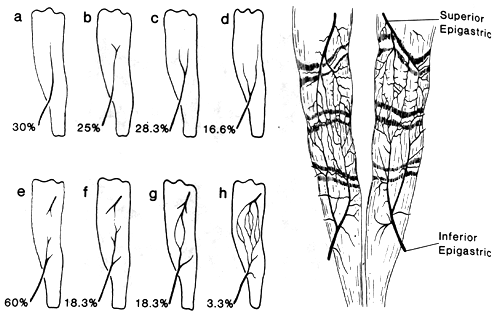

Illustrated Encyclopedia of Human Anatomic Variation: Opus II: Cardiovascular System
Ronald A. Bergman, PhD
Adel K. Afifi, MD, MS
Ryosuke Miyauchi, MD
Peer Review Status: Internally Peer Reviewed

A: The frequency of various configurations of the inferior epigastric artery after dissection are shown in a, b, c, and d. The lower set of figures shows the anastomoses or absence thereof as revealed by dissection: e, no anastomosis; f, 1 anastomosis; g, 2 anastomoses; and h, multiple anastomoses.
B: The rectus muscles with the epigastric arteries dissected. A special dissection of a specimen with many anastomoses between superior and inferior epigastric arteries. This dissection also illustrates the manner in which arteries tend to follow the tendinous inscriptions.
The authors provide the following conclusions from their study: The rectus muscles are variable in length and width, tending to parallel body build in their relative dimensions. In the majority of cases the two recti are of equal length, and measure between 34 and 38 centimeters.
The two rectus muscles in a given individual usually have the same number of inscriptions, and in half of the bodies in this series the number was 3 on each side. No muscle had more than 4 inscriptions.
The deep inferior epigastric artery was present in all bodies bilaterally, most frequently as a single-stem vessel lying on the posterior aspect of the rectus, and entering the substance of the muscle in its middle third.
The superior epigastric artery is occasionally not seen on the dorsal surface of the rectus, being either absent or buried in muscle tissue. When present, it is usually a single stem that enters the medial portion of the muscle after a short course on the surface.
In only 1 instance, in this series of 162 muscles examined, did the superior and inferior epigastric vessels anastomose on the surface of the rectus muscle in the pattern frequently depicted in anatomy texts. Furthermore, when muscle fibers had been dissected away from the arteries, only 40 per cent of the superior and inferior epigastric arteries were found to have any gross anastomoses.
Three or 4 small branches of the inferior epigastric artery commonly pass laterally through the linea semilunaris into the plane between the transversus abdominis and internal oblique muscles of the abdomen. These vessels usually leave the middle two-fourths of the muscle from its posterior aspect, and they most frequently accompany branches of the ninth, tenth, or eleventh thoracic nerves. These vessels were dissected out to their termination, and it was found that only 15 per cent anastomosed with intercostal or circumflex iliac arteries. The remaining vessels terminated most commonly in the transversus abdominis in the upper abdomen and in the internal oblique in the lower abdomen.
Finally, the data on arterial anastomoses were re-examined to discover whether there was an increased number of anastomoses between epigastric and intercostal vessels in those bodies with grossly demonstrable anastomoses between superior and inferior epigastric arteries. It was found that there was no increased tendency for such anastomoses to occur between epigastric and intercostal vessels when grossly demonstrable connections between the superior and the inferior epigastric arteries were present.
Redrawn from Milloy, F.J., Anson, B.J. and D.K. McAfee. The rectus abdominis muscle and the epigastric arteries. Surg. Gynecol. Obstet 110:293-302, 1960.
Section Top | Title Page
Please send us comments by filling out our Comment Form.
All contents copyright © 1995-2025 the Author(s) and Michael P. D'Alessandro, M.D. All rights reserved.
"Anatomy Atlases", the Anatomy Atlases logo, and "A digital library of anatomy information" are all Trademarks of Michael P. D'Alessandro, M.D.
Anatomy Atlases is funded in whole by Michael P. D'Alessandro, M.D. Advertising is not accepted.
Your personal information remains confidential and is not sold, leased, or given to any third party be they reliable or not.
The information contained in Anatomy Atlases is not a substitute for the medical care and advice of your physician. There may be variations in treatment that your physician may recommend based on individual facts and circumstances.
URL: http://www.anatomyatlases.org/